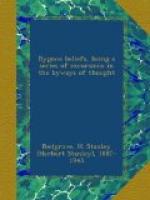[2] Professor AUGUSTUS DE MORGAN: A Budget of Paradoxes (1872), p 66.
[3] THOMAS JOSEPH PETTIGREW, F.R.S.: On Superstitions connected with the History and Practice of Medicine and Surgery (1844), pp. 164-167.
VI
THE BELIEF IN TALISMANS
THE word “talisman” is derived from the Arabic “tilsam,” “a magical image,” through the plural form “tilsamen.” This Arabic word is itself probably derived from the Greek telesma in its late meaning of “a religious mystery” or “consecrated object”. The term is often employed to designate amulets in general, but, correctly speaking, it has a more restricted and special significance. A talisman may be defined briefly as an astrological or other symbol expressive of the influence and power of one of the planets, engraved on a sympathetic stone or metal (or inscribed on specially prepared parchment) under the auspices of this planet.
Before proceeding to an account of the preparation of talismans proper, it will not be out of place to notice some of the more interesting and curious of other amulets. All sorts of substances have been employed as charms, sometimes of a very unpleasant nature, such as dried toads. Generally, however, amulets consist of stones, herbs, or passages from Sacred Writings written on paper. This latter class are sometimes called “characts,” as an example of which may be mentioned the Jewish phylacteries.
Every precious stone was supposed to exercise its own peculiar virtue; for instance, amber was regarded as a good remedy for throat troubles, and agate was thought to preserve from snake-bites. ELIHU RICH[1] gives a very full list of stones and their supposed virtues. Each sign of the zodiac was supposed to have its own particular stone[2] (as shown in the annexed table), and hence the superstitious though not inartistic custom of wearing one’s birth-




